Apple MacBook Pro 13: Can a Mac Be a Decent Windows Laptop?
by Vivek Gowri on October 14, 2010 9:00 PM ESTApple MacBook Pro 13—Core 2 Duo Performance
It’s kind of embarrassing to be reviewing a $1200 computer with a two year old processor and application performance to match. It’s not that evident in day to day use, and in most games performance is more dependant on the graphics card, but application performance benchmarks are where the Core 2 Duo really makes itself felt (and not in a good way).
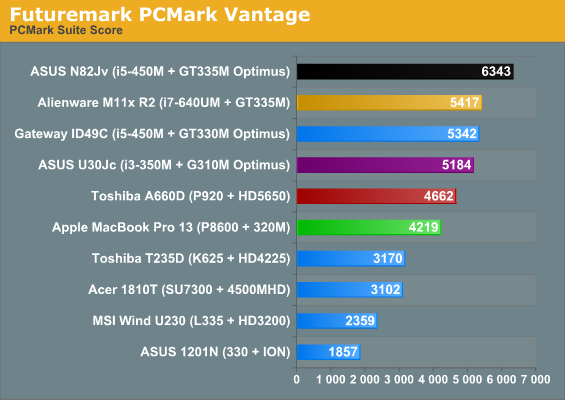
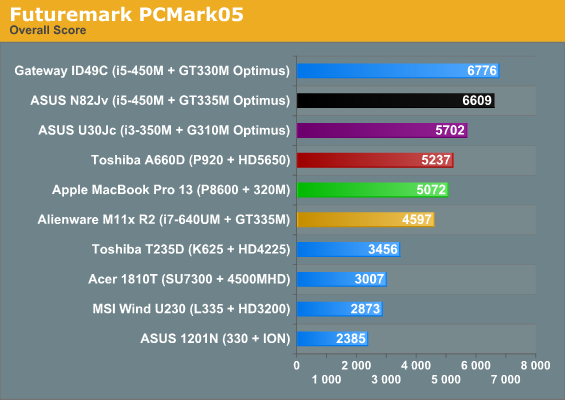
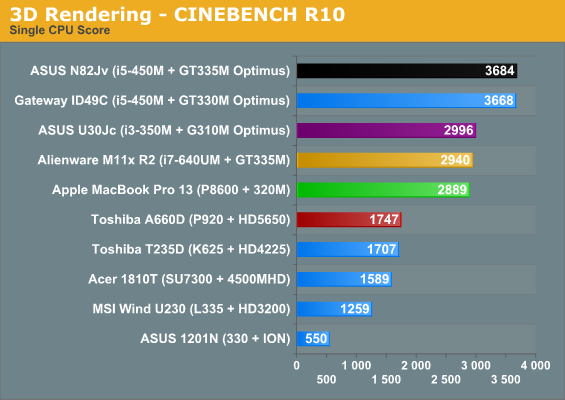
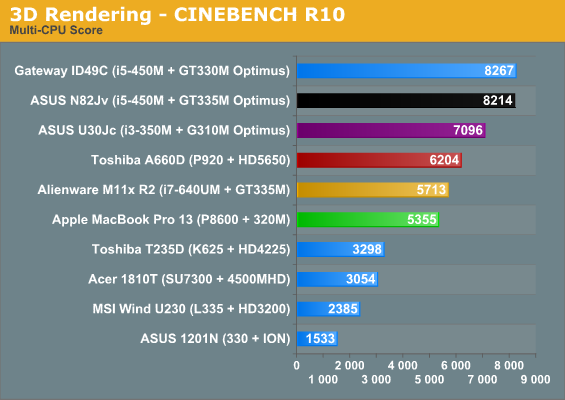
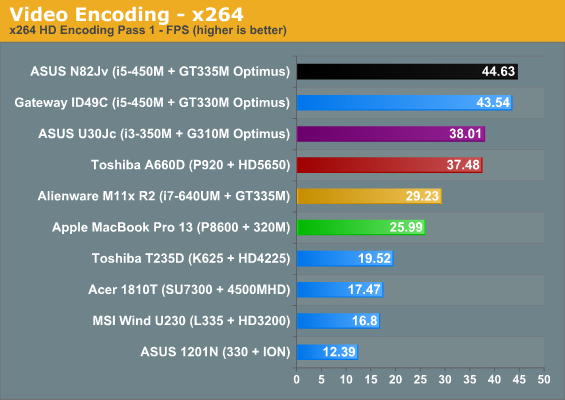
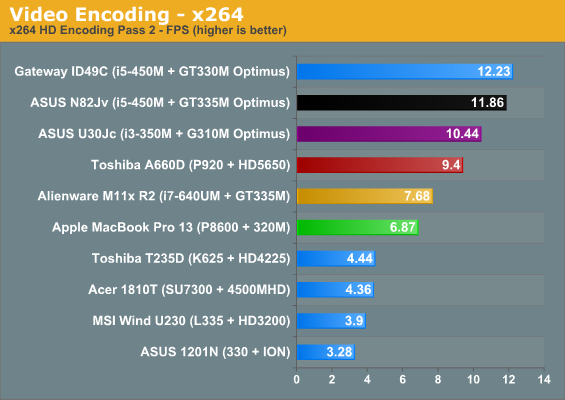
Here’s why it’s really sad: the MBP13 results would fit pretty well in our old Core 2 Duo notebook roundups, like this one from two years ago. The G50V and dv5t were $1200 notebooks back then, and they’re basically on par with the current MBP13. Quite frankly, it’s almost pathetic that Apple decided they could get away with a Core 2-based processor for another year at a price point that can get you a 14” aluminum unibody notebook with a quad core i7-720QM (HP, we’d still like to test an Envy 14, thanks). People expect Macs to cost more almost by default, but after a couple of years of the MBP13 being a decent value for a premium quality notebook (look at the old Envy 13 for comparison), it’s particularly jarring now to see it be so far behind the competition. I have none of these complaints for the Core i5/i7 sporting 15” and 17” models, however.
At this juncture, any notebook with a Core i3 can outrun the MBP. Same goes for the Core i7 ULV chip. We’ve never tested a Core i5 ULV, but we'll see the Core i3 ULV in a review shortly and it's in the same ballpark as Core 2—and the overclocked Core i3-330UM in the ASUS UL80Jt is basically on par with the MBP.
There are two ways you can look at this; you can say that at this point, anything with a Core 2 (even an old Merom) is more than powerful enough to run Windows and handle any reasonable task a thin and light notebook might be asked to. A lot of Apple fans say that. There’s another camp that says it’s completely unreasonable for Apple to sell a notebook with a Core 2 Duo processor at $1200, regardless of what it might be asked to do—there are smaller, thinner, lighter systems that perform better in basically every way. A lot of anti-Apple fans say that. They’re both right.
The Core 2 Duo is most certainly adequate to handle the normal, every day rigors of a portable notebook, but that’s not a reasonable justification for Apple selling a notebook that is more expensive than more powerful competitors. Apple is getting a bargain price on P8600 CPUs and the 320M chipset, which means the Core 2 + 320M is more about increasing profit margins than anything else. (And for those people who still cling to the theory that Apple couldn’t fit a third chip onto the board without reducing the battery size or making the notebook larger, that’s nonsense. If ASUS can manage to fit a Core 2010 processor, the chipset, and a dedicated graphics card into a system with similar dimensions to the MBP13 and a 33% larger battery, then Apple could have too. Simple as that.)
While we're here, we also ran all the 3DMark suites. This hints at the Core 2 + 320M combination being a lot more impressive than the above results, but then why couldn't Apple get GT 320M or faster with switching graphics into the system instead? Oh, right: that's only for 15" and 17" MBP. More on this when you hit the next page.
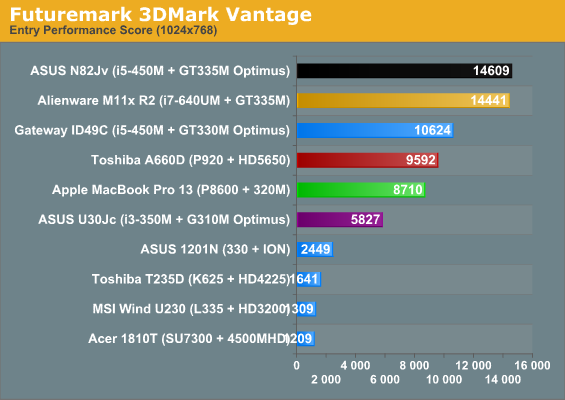
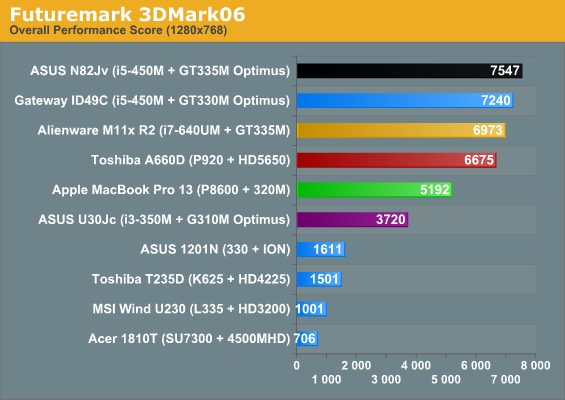
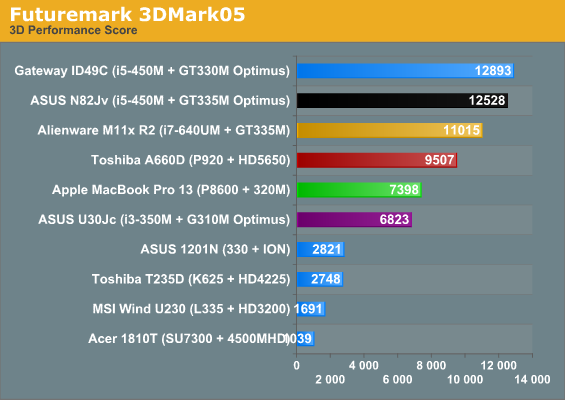
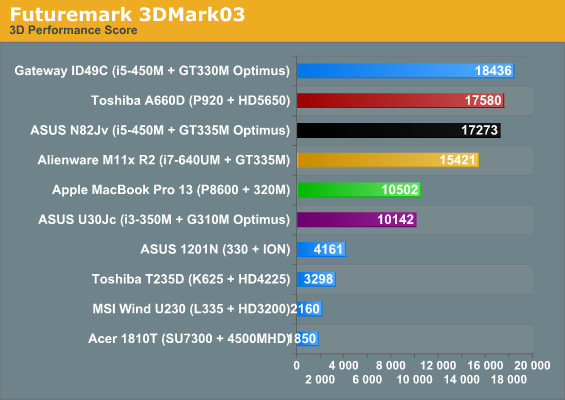
Okay, 320M looks decent, but the CPU is still old. We'll get into the graphics stuff on the next page, but while we're here looking at 3DMarks, we do have a quick question: how many of you want us to continue posting 3DMark results with our laptop reviews? We know they're a consistent point of reference for the long-term, but 03 and 05 in particular are getting very long in the tooth. So, if you want to sound off in the comments, would you like us to ditch 3DMark entirely, keep 06 and Vantage, keep all four like we've got above, or only skip 03/05?










117 Comments
View All Comments
JarredWalton - Friday, October 15, 2010 - link
I'm completely aware of the fact that Apple has a business and a boutique mentality. That doesn't mean I have to support that idea, though, and it's one of the things that makes me despise Macs. Call it what you will, but the facts are Apple overcharges compared to the vast majority of Windows PCs. (Sony also fits that description in my book.) Yes, quality costs extra, but they're milking it pretty hard.The MacBook 2009 model was virtually the same as the current model. The only real change is the chipset/IGP, which was really trivial in my book. Yes, the 320M does a lot for graphics performance, but on the R&D side Apple didn't have to do anything really. Then they took the profits and didn't pass them on, and it's working fine based on sales so who can really fault them? At the same time, I'm not going to praise them for their actions -- just like I don't praise Microsoft for charging an arm and a leg for Office, which hasn't radically improved in over a decade. (Yes, I could easily do 99% of what I need with Office '97.)
So congrats to Apple for making money. I only wish the competition would step up to the plate a bit and compete on quality, features, price, etc. rather than just giving the high end and higher margins away. ASUS keeps trying to get a piece of the pie, but they keep missing on the LCD and build quality while easily winning the performance and other features. Give me the N82Jv with a better chassis, LCD, and larger battery for under $1200 and I'd never even consider a MacBook Pro.
podpi - Thursday, October 14, 2010 - link
answers all my questions, was no effort to read and all your recommendations seem spot on the money too!dexpert - Thursday, October 14, 2010 - link
I'd like to point out a small error. You stated that the 13" MacBook Pro has a slightly faster CPU than the white MacBook, 2.4GHz vs. 2.26. Actually, the white MB currently has the same 2.4GHz Core 2 Duo as the low-end MBP.I've also seen several recent articles stating that the white MacBook has a bad display. While that was certainly true for the pre-unibody models, the newer plastic unibody MacBooks have much better displays. The viewing angles are much better (for TN panels anyway), it's much brighter and the contrast has been improved a lot as well. I'd say the unibody white MacBook's display is basically a 13" MacBook Pro's display with somewhat less contrast.
VivekGowri - Thursday, October 14, 2010 - link
Oops, my bad. I'll fix that. But putting them side by side, you can pretty clearly see that the MBP is pretty far superior to the unibody plastic MacBook.dexpert - Friday, October 15, 2010 - link
Oh yeah, I definitely agree that the 13" MBP is definitely the better value of the two.EclipsedAurora - Thursday, October 14, 2010 - link
>>>The aluminum unibody construction, faster CPU (2.4GHz vs 2.26), RAM upgrade (4GB vs 2GB), backlit keyboard, and SD card reader are just bonuses. It’s thinner, lighter, and has more features, along with a far better display.Such an aluminum design was originally used by Sony in her original 2003 VAIO Z. Japanese notebook leader like Toshiba, Fujitsu and Sony have long dumped aluminium design in favour carbon fiber chasis to further reduce weight. Of course most of these high end models are not available world wide.
Macbook Pro 13" has a nearly 2kg weight, which is too heavy in today's standard. In comparation, latest 13" VAIO Z weights at 1.39kg only even with similar 6 cells battery, dedicated GPU, TPM and fingerprint security hardware! Furthermore, a 600g reduction can let you bring another iPaq or VAIO X on the street!
disappointed1 - Friday, October 15, 2010 - link
As per your often repeated advice (as recently as in http://www.anandtech.com/show/3973/nvidias-geforce..."As we’ve mentioned before we’re not huge fans of synthetic tests like 3DMark since they encourage non-useful driver optimizations for the benchmark instead of real games..."
3DMark is a pure synthetic and offers no useful information on actual relevant performance - and worse, its purchase is now required (Vantage) in order to be run at home by readers looking to compare. 3DMarks are meaningless, arbitrary numbers.
Performance across product generations isn't really any different than performance across major product categories within the same generation, and could just as easily be measured with a scalable real-world application, should you choose to maintain one in your benchmark suite. I think Far Cry 2 would be a prime candidate in this respect. Give us something useful, like frames-per-second in an actual game.
Sufo - Friday, October 15, 2010 - link
mm, while i agree with you to an extent, i think "3DMarks are meaningless, arbitrary numbers." is something of an overstatement - and i'm sure you yourself were aware of perhaps a little exaggeration creeping in here.Look at something like IMDB (even more wildly subjective). If you were to guage whether you were going to enjoy a film purely on the back of the score listed there, you would most likely be a fool - however were you to take that number as merely one factor while reading other reviews and so on, you'd most likely find that contextually it is somewhat indicative of certain features (for example, one might conclude that from a high IMDB score, and some low reiewer scores that the film, while perhaps of weak script and acting, is nonetheless entertaining for various reasons).
Despite the verbosity of the aforediscussed comparison, the same does hold for PC benchmarks too. They are just one part of a whole, complete, testing suite. They are the equivalent of a game - and suggesting that we include FC2, while a perfectly sound suggestion, is not really that much better than suggesting the addition of another benchmark. All one would find out would be how some specifc hardware performs in some specific game. Which in all its subjectivity is fine, it's as it should be - it's what we want.
Finally, i suppose if it is not obvious, i should express my opinion on the matter of whetehr we shoudl keep said benches or not - well of course yes, adding the results of a known quantity like a 3DMark bench can only help to enrich the assesment of the hardware - however similarly, i'd suggest keeping things current, and unless testing netbooks or the like, omitting the 03 and 05 flavours is probably a good shout.
JarredWalton - Friday, October 15, 2010 - link
That's one yes, and one no. Unfortunately, that doesn't give us much input. LOL. Most likely we'll drop 03/05 shortly (outside of netbooks that still can't run 06 well, and Vantage not at all).hybrid2d4x4 - Friday, October 15, 2010 - link
Put me down as another in favor of dropping them. I know that when I read the reviews, I skip over the synthetic charts entirely (unless real-world tests are altogether missing- not so much a concern on this site).